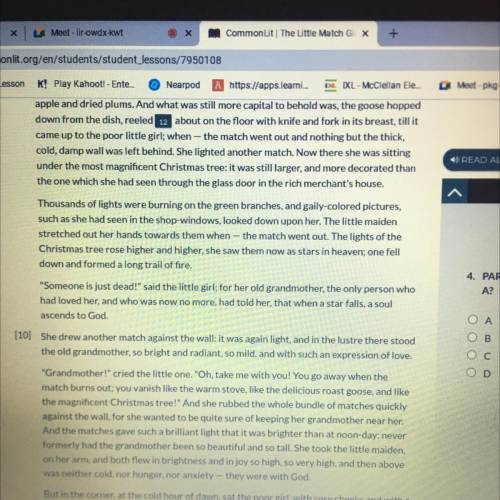

Answers: 2
Another question on English

English, 21.06.2019 19:00
Modernist poetry broke traditions in works that did all of the following except: question 1 options: a) experimented with language, symbolism, and imagery b) challenged rules about point of view, rhyme scheme, meter, and capitalization c) focused on the poem’s appearance on the page as a form of self-expression d) addressed subjects and ideas that had been explored in poetry for centuries. while mr. flood is not heroic in the typical sense and does nothing admirable during the poem’s action, robinson’s description of mr. flood is nevertheless filled with pathos, which a) the poem is filled with language and descriptions which arouse emotion, usually pity and sympathy, from the reader. b) the poem is filled with nonsensical events that make the reader laugh at mr. flood’s expense. c) the poem gives vivid sensory details that make the reader feel like they are a part of the story. d) the poem is tedious and drawn out with details that don’t influence the reader at all. refer to the william carlos williams poem "spring and all" (on pages 306-7 in your textbook), to answer the prompt below. your response should be 1-2 well-developed paragraphs and should include specific details (quotes) from the poem that support your analysis. cite your textual evidence as well. you should use your journeys book. because “spring and all” ends with language and imagery that suggest birth and growth, many readers consider it a hopeful poem that celebrates the first steps toward new life and away from a wintry world characterized by death and decay. consider the poem’s date of publication—1923—and the historical events that influenced many modern writers, specifically, world war i. poem below: by the road to the contagious hospital under the surge of the blue mottled clouds driven from the northeast-a cold wind. beyond, the waste of broad, muddy fields brown with dried weeds, standing and fallen patches of standing water the scattering of tall trees all along the road the reddish purplish, forked, upstanding, twiggy stuff of bushes and small trees with dead, brown leaves under them leafless vines- lifeless in appearance, sluggish dazed spring approaches- they enter the new world naked, cold, uncertain of all save that they enter. all about them the cold, familiar wind- now the grass, tomorrow the stiff curl of wildcarrot leaf one by one objects are defined- it quickens: clarity, outline of leaf but now the stark dignity of entrance-still, the profound change has come upon them: rooted, they grip down and begin to awaken how might “spring and all” be interpreted as a reaction to the violence of world war 1? be sure to cite examples from the poem to support your analysis.
Answers: 2

English, 21.06.2019 20:10
Which analysis best explains the effect of adding the female character in the film adaptation of the scene? ger. and tom al a o she advances the plot. having her run through the jungle moves the events of the story along. she serves a practical function. using her bracelet to create the trap makes it more realistic to the audience she raises the stakes. giving the audience someone else to care about increases the suspense level, she makes the film prettier. having a beautiful female character is mostly decorative, creating a nice visual, tness, here, again
Answers: 1

English, 22.06.2019 07:30
The reader can conclude that the passage is part of an epic poem because rama
Answers: 2

English, 22.06.2019 08:40
Read the passage from sugar changed the world. but it is in india, where it was used as an offering in religious and magical ceremonies, that we have the first written record of sugar. long before the first pyramids were built in egypt, the ancient sumerians traded with the people of harappa and mohenjo daro, who lived along the indus river. unfortunately, we are still not able to read the writings left behind from those ancient cities. so the first documents telling us about life in that region come from a much later period. these hindu sacred teachings were probably first gathered together sometime between 1500 and 900 b.c., and were carefully memorized. only hundreds of years later were they finally written down. the hindu writings tell us of a religion in which fire was extremely important. people believed that the gods gave fire to human beings. yet fire was also a way for humans to reach the gods. by placing offerings in a special fire, a priest could turn them into smoke and send them on to the gods. five ingredients were selected for this special burning: milk, cheese, butter, honey, and sugar cane. which details would best fit in a summary of this passage? select two options. "in india . . it was used as an offering in religious and magical ceremonies" "the first written record of sugar" "long before the first pyramids were built in egypt" "gods gave fire to human beings" "a priest could turn them into smoke and send them on to the gods"
Answers: 2
You know the right answer?
4. PART B: Which detail from the story best supports your answer to Part
A?
A "against the wa...
A "against the wa...
Questions

Medicine, 24.11.2020 19:50


Mathematics, 24.11.2020 19:50



Mathematics, 24.11.2020 19:50


Mathematics, 24.11.2020 19:50



Chemistry, 24.11.2020 19:50





Mathematics, 24.11.2020 19:50



Advanced Placement (AP), 24.11.2020 19:50

Mathematics, 24.11.2020 19:50




